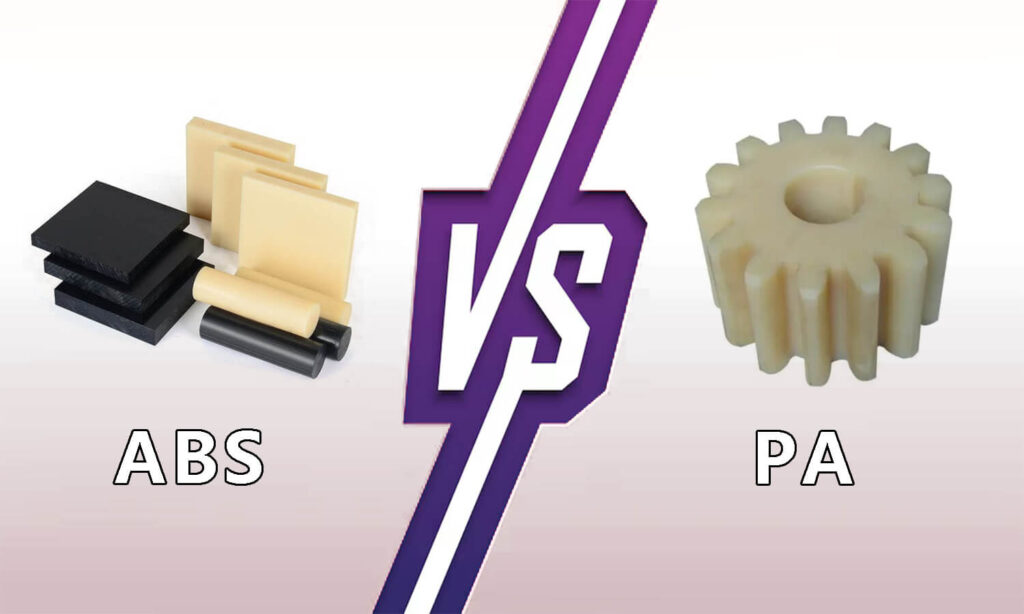Bevezetés
A mai ipari környezetben a megfelelő anyag kiválasztása jelentheti a különbséget a termék teljesítménye, tartóssága és költséghatékonysága szempontjából. Az ABS (akrilnitril-butadién-sztirol) és a PA (poliamid, közismert nevén nylon) két népszerű hőre lágyuló műanyag, amelyet széles körben használnak a különböző iparágakban, az autóipartól a szórakoztató elektronikáig. Az ABS és a PA közötti különbségek megértése kulcsfontosságú a gyártók, mérnökök és terméktervezők számára, akik a funkcionalitás és a gazdaságosság egyensúlyát keresik. Az ABS vs PA, ez a cikk az ABS és a PA legfontosabb különbségeit, tulajdonságait és alkalmazásait vizsgálja, hogy segítse Önt a megalapozott anyagválasztásban.

ABS - Jellemzők és alkalmazások
Az ABS meghatározása és összetétele
Az ABS egy kopolimer, amelyet akrilnitril, butadién és sztirol kombinálásával állítanak elő, és egy tartós műanyagot eredményez, amely robosztusságáról, ütésállóságáról és költséghatékonyságáról ismert. Ez az összetétel lehetővé teszi az ABS könnyű formázhatóságát, így ideális összetett minták és részletes formák készítéséhez.
Az ABS legfontosabb tulajdonságai
Az ABS-t mechanikai szilárdsága, szívóssága, valamint karcolásokkal és horpadásokkal szembeni ellenállása miatt tartják nagyra. Emellett jó méretstabilitással rendelkezik, és ellenáll a mérsékelt hő- és környezeti tényezőknek, bár nem alkalmas nagy hőhatású alkalmazásokhoz.
Az ABS gyakori alkalmazásai
Autóipar: Az ABS-t széles körben használják az autók belsejében, műszerfalaiban és díszítőelemekben, ahol a tartósság és a könnyű gyárthatóság prioritást élvez.
Szórakoztató elektronika: Számos elektronikus eszköz, például laptopok, telefonok és távirányítók burkolata ABS-ből készül, mivel könnyű és ütésálló.
Háztartási készülékek: A porszívóktól a hűtőszekrények polcaiig az ABS népszerű választás olyan alkatrészekhez, amelyeknek merevségre és tartósságra van szükségük gyakori használat mellett.
PA - Jellemzők és alkalmazások
A PA meghatározása és összetétele (Nylon)
A poliamid, közismert nevén nejlon, egyfajta szintetikus polimer, amely kőolajból származik. Erős szálszerkezetéről ismert, amely nagy szakítószilárdságot, rugalmasságot és kopásállóságot biztosít.
A PA legfontosabb tulajdonságai
A PA szilárdsága és rugalmassága, valamint kiváló kémiai és kopásállósága miatt kiválóan alkalmas igényes alkalmazásokhoz. Ellenáll a magas hőmérsékletnek, és gyakran használják olyan környezetben, ahol mechanikai szilárdságot igénylő, terhelés alatti igénybevételre van szükség.
A PA gyakori alkalmazásai
Mérnöki és ipari alkalmazások: Nagy tartóssága és kopásállósága miatt a PA-t gyakran használják fogaskerekek, csapágyak és gépalkatrészek készítéséhez.
Textilipar: A nejlon a textilipar egyik alapanyaga, amely rugalmassága és szívóssága miatt megtalálható a ruházatban, kárpitozásban és sportruházatban.
Fogyasztási cikkek: Az olyan mindennapi tárgyak, mint a fogkefe sörtéi, a horgászzsinórok és a csomagolóanyagok profitálnak a PA rugalmasságából és sokoldalúságából.
Az ABS és a PA részletes összehasonlítása
Mechanikai tulajdonságok
Erő és merevség: A PA általában nagyobb szakítószilárdsággal és rugalmassággal rendelkezik, mint az ABS, ami alkalmassá teheti a nagy igénybevételnek és mozgásnak kitett alkatrészekhez.
Ütésállóság: Az ABS kiváló ütésállóságáról ismert, így jobb választás az ütéscsillapítást igénylő alkalmazásokhoz.
Kémiai ellenállás
A PA jobban ellenáll a vegyi anyagoknak és oldószereknek, különösen az olajokkal és zsírokkal szemben, míg az ABS hajlamosabb a vegyi hatásoknak való kitettség alatti lebomlásra.
Termikus tulajdonságok
Az ABS ellenáll a mérsékelt hőmérsékletnek, így alkalmas általános célú alkalmazásokhoz, míg a PA nagyobb hőstabilitása lehetővé teszi, hogy magas hőmérsékletű környezetben is jól teljesítsen.
Költségek összehasonlítása
Az ABS általában költséghatékonyabb, mint a PA, ezért olyan alkalmazásokban, ahol a költségvetési korlátok jelentősek, és nem szükségesek a nagy teljesítményű tulajdonságok, ez az anyag a választás.
A megfelelő anyag kiválasztása
Figyelembe veendő tényezők
Speciális alkalmazási követelmények: A tervezett felhasználás jelentős szerepet játszik. Nagy igénybevételű alkalmazásokhoz a PA szilárdsága megfelelőbb lehet, míg az ABS kedvezőbb árú, alacsony igénybevételű alkalmazásokhoz.
Környezeti megfontolások: Vegye figyelembe, hogy a termék milyen környezetnek lesz kitéve. A PA előnyösebb a vegyi anyagokkal terhelt környezetben, míg az ABS ideális az alacsony expozíciónak kitett alkalmazásokhoz.
Döntéshozatali folyamat
Az alkalmazási követelmények, a költségvetési korlátok és a környezeti tényezők értékelése segíthet az anyagválasztásban. Mindkét anyaggal végzett prototípus-készítés is hasznos lehet a valós teljesítmény felméréséhez.
Gyakran ismételt kérdések (GYIK)
A. Mik a fő különbségek az ABS és a PA között?
Az ABS ütésállóságáról és megfizethetőségéről ismert, míg a PA-t szakítószilárdsága, hőállósága és stresszállósága miatt értékelik. Mindegyik anyagnak megvannak a különböző alkalmazásokhoz illeszkedő előnyei.
B. Melyik anyag jobb az autóipari alkalmazásokhoz?
Az ABS-t gyakran használják az autóipari belső alkatrészeknél a formázhatósága és költséghatékonysága miatt, de az olyan nagy igénybevételnek kitett alkatrészeknél, mint a fogaskerekek és perselyek, a PA lehet az előnyösebb választás szilárdsága miatt.
C. Újrahasznosítható-e az ABS és a PA?
Igen, mind az ABS, mind a PA újrahasznosítható. Az ABS megolvasztható és újraformázható, míg a PA magas olvadáspontja és szívóssága miatt speciális újrahasznosítási folyamatokat igényel.
Az ABS vs. PA következtetése
Az ABS és a PA sokoldalú hőre lágyuló műanyagok, amelyek különböző tulajdonságokkal rendelkeznek, és ezért különböző alkalmazásokban értékesnek bizonyulnak. Míg az ABS ütésállóságot és megfizethetőséget kínál, addig a PA szilárdságával, vegyszerállóságával és hőmérséklet-tűrésével tűnik ki. A megfelelő anyag kiválasztása az egyedi követelményektől függ, beleértve a mechanikai igényeket, a környezeti tényezőket és a költségvetési korlátokat. E tényezők gondos mérlegelésével a vállalkozások és a gyártók optimalizálhatják a termékek teljesítményét, hosszú élettartamát és költséghatékonyságát. A megfelelő anyag kiválasztása jobb termékelégedettséghez, jobb tartóssághoz és végső soron okosabb befektetéshez vezethet.
